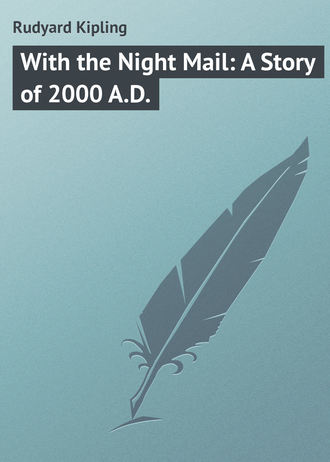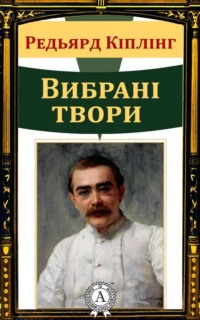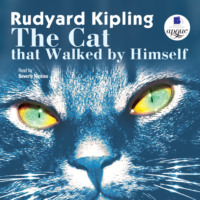 полная версия
полная версияWith the Night Mail: A Story of 2000 A.D.

Kipling Rudyard
With the Night Mail: A Story of 2000 A.D. / (Together with extracts from the comtemporary magazine in which it appeared)
With the Night Mail
At nine o'clock of a gusty winter night I stood on the lower stages of one of the G. P. O. outward mail towers. My purpose was a run to Quebec in "Postal Packet 162 or such other as may be appointed"; and the Postmaster-General himself countersigned the order. This talisman opened all doors, even those in the despatching-caisson at the foot of the tower, where they were delivering the sorted Continental mail. The bags lay packed close as herrings in the long gray under-bodies which our G. P. O. still calls "coaches." Five such coaches were filled as I watched, and were shot up the guides to be locked on to their waiting packets three hundred feet nearer the stars.
From the despatching-caisson I was conducted by a courteous and wonderfully learned official – Mr. L. L. Geary, Second Despatcher of the Western Route – to the Captains' Room (this wakes an echo of old romance), where the mail captains come on for their turn of duty. He introduces me to the Captain of "162" – Captain Purnall, and his relief, Captain Hodgson. The one is small and dark; the other large and red; but each has the brooding sheathed glance characteristic of eagles and aëronauts. You can see it in the pictures of our racing professionals, from L. V. Rautsch to little Ada Warrleigh – that fathomless abstraction of eyes habitually turned through naked space.
On the notice-board in the Captains' Room, the pulsing arrows of some twenty indicators register, degree by geographical degree, the progress of as many homeward-bound packets. The word "Cape" rises across the face of a dial; a gong strikes: the South African mid-weekly mail is in at the Highgate Receiving Towers. That is all. It reminds one comically of the traitorous little bell which in pigeon-fanciers' lofts notifies the return of a homer.
"Time for us to be on the move," says Captain Purnall, and we are shot up by the passenger-lift to the top of the despatch-towers. "Our coach will lock on when it is filled and the clerks are aboard."…
"No. 162" waits for us in Slip E of the topmost stage. The great curve of her back shines frostily under the lights, and some minute alteration of trim makes her rock a little in her holding-down slips.
Captain Purnall frowns and dives inside. Hissing softly, "162" comes to rest as level as a rule. From her North Atlantic Winter nose-cap (worn bright as diamond with boring through uncounted leagues of hail, snow, and ice) to the inset of her three built-out propeller-shafts is some two hundred and forty feet. Her extreme diameter, carried well forward, is thirty-seven. Contrast this with the nine hundred by ninety-five of any crack liner and you will realize the power that must drive a hull through all weathers at more than the emergency-speed of the "Cyclonic"!
The eye detects no joint in her skin plating save the sweeping hair-crack of the bow-rudder – Magniac's rudder that assured us the dominion of the unstable air and left its inventor penniless and half-blind. It is calculated to Castelli's "gull-wing" curve. Raise a few feet of that all but invisible plate three-eighths of an inch and she will yaw five miles to port or starboard ere she is under control again. Give her full helm and she returns on her track like a whip-lash. Cant the whole forward – a touch on the wheel will suffice – and she sweeps at your good direction up or down. Open the complete circle and she presents to the air a mushroom-head that will bring her up all standing within a half mile.
"Yes," says Captain Hodgson, answering my thought, "Castelli thought he'd discovered the secret of controlling aëroplanes when he'd only found out how to steer dirigible balloons. Magniac invented his rudder to help war-boats ram each other; and war went out of fashion and Magniac he went out of his mind because he said he couldn't serve his country any more. I wonder if any of us ever know what we're really doing."
"If you want to see the coach locked you'd better go aboard. It's due now," says Mr. Geary. I enter through the door amidships. There is nothing here for display. The inner skin of the gas-tanks comes down to within a foot or two of my head and turns over just short of the turn of the bilges. Liners and yachts disguise their tanks with decoration, but the G. P. O. serves them raw under a lick of gray official paint. The inner skin shuts off fifty feet of the bow and as much of the stern, but the bow-bulkhead is recessed for the lift-shunting apparatus as the stern is pierced for the shaft-tunnels. The engine-room lies almost amidships. Forward of it, extending to the turn of the bow tanks, is an aperture – a bottomless hatch at present – into which our coach will be locked. One looks down over the coamings three hundred feet to the despatching-caisson whence voices boom upward. The light below is obscured to a sound of thunder, as our coach rises on its guides. It enlarges rapidly from a postage-stamp to a playing-card; to a punt and last a pontoon. The two clerks, its crew, do not even look up as it comes into place. The Quebec letters fly under their fingers and leap into the docketed racks, while both captains and Mr. Geary satisfy themselves that the coach is locked home. A clerk passes the waybill over the hatch-coaming. Captain Purnall thumb-marks and passes it to Mr. Geary. Receipt has been given and taken. "Pleasant run," says Mr. Geary, and disappears through the door which a foot-high pneumatic compressor locks after him.
"A-ah!" sighs the compressor released. Our holding-down clips part with a tang. We are clear.
Captain Hodgson opens the great colloid underbody-porthole through which I watch million-lighted London slide eastward as the gale gets hold of us. The first of the low winter clouds cuts off the well-known view and darkens Middlesex. On the south edge of it I can see a postal packet's light ploughing through the white fleece. For an instant she gleams like a star ere she drops toward the Highgate Receiving Towers. "The Bombay Mail," says Captain Hodgson, and looks at his watch. "She's forty minutes late."
"What's our level?" I ask.
"Four thousand. Aren't you coming up on the bridge?"
The bridge (let us ever bless the G. P. O. as a repository of ancientest tradition!) is represented by a view of Captain Hodgson's legs where he stands on the control platform that runs thwartships overhead. The bow colloid is unshuttered and Captain Purnall, one hand on the wheel, is feeling for a fair slant. The dial shows 4,300 feet.
"It's steep to-night," he mutters, as tier on tier of cloud drops under. "We generally pick up an easterly draught below three thousand at this time o' the year. I hate slathering through fluff."
"So does Van Cutsem. Look at him huntin' for a slant!" says Captain Hodgson. A fog-light breaks cloud a hundred fathoms below. The Antwerp Night Mail makes her signal and rises between two racing clouds far to port, her flanks blood-red in the glare of Sheerness Double Light. The gale will have us over the North Sea in half an hour, but Captain Purnall lets her go composedly – nosing to every point of the compass as she rises.
"Five thousand – six, six thousand eight hundred" – the dip-dial reads ere we find the easterly drift, heralded by a flurry of snow at the thousand-fathom level. Captain Purnall rings up the engines and keys down the governor on the switch before him. There is no sense in urging machinery when Æolus himself gives you good knots for nothing. We are away in earnest now – our nose notched home on our chosen star. At this level the lower clouds are laid out all neatly combed by the dry fingers of the East. Below that again is the strong westerly blow through which we rose. Overhead, a film of southerly drifting mist draws a theatrical gauze across the firmament. The moonlight turns the lower strata to silver without a stain except where our shadow underruns us. Bristol and Cardiff Double Lights (those statelily inclined beams over Severnmouth) are dead ahead of us; for we keep the Southern Winter Route. Coventry Central, the pivot of the English system, stabs upward once in ten seconds its spear of diamond light to the north; and a point or two off our starboard bow The Leek, the great cloud-breaker of Saint David's Head, swings its unmistakable green beam twenty-five degrees each way. There must be half a mile of fluff over it in this weather, but it does not affect The Leek.
"Our planet's overlighted if anything," says Captain Purnall at the wheel, as Cardiff-Bristol slides under. "I remember the old days of common white verticals that 'ud show two or three thousand feet up in a mist, if you knew where to look for 'em. In really fluffy weather they might as well have been under your hat. One could get lost coming home then, an' have some fun. Now, it's like driving down Piccadilly."
He points to the pillars of light where the cloud-breakers bore through the cloud-floor. We see nothing of England's outlines: only a white pavement pierced in all directions by these manholes of variously coloured fire – Holy Island's white and red – St. Bee's interrupted white, and so on as far as the eye can reach. Blessed be Sargent, Ahrens, and the Dubois brothers, who invented the cloud-breakers of the world whereby we travel in security!
"Are you going to lift for The Shamrock?" asks Captain Hodgson. Cork Light (green, fixed) enlarges as we rush to it. Captain Purnall nods. There is heavy traffic hereabouts – the cloud-bank beneath us is streaked with running fissures of flame where the Atlantic boats are hurrying Londonward just clear of the fluff. Mail-packets are supposed, under the Conference rules, to have the five-thousand-foot lanes to themselves, but the foreigner in a hurry is apt to take liberties with English air. "No. 162" lifts to a long-drawn wail of the breeze in the fore-flange of the rudder and we make Valencia (white, green, white) at a safe 7,000 feet, dipping our beam to an incoming Washington packet.
There is no cloud on the Atlantic, and faint streaks of cream round Dingle Bay show where the driven seas hammer the coast. A big S. A. T. A. liner (Société Anonyme des Transports Aëriens) is diving and lifting half a mile below us in search of some break in the solid west wind. Lower still lies a disabled Dane: she is telling the liner all about it in International. Our General Communication dial has caught her talk and begins to eavesdrop. Captain Hodgson makes a motion to shut it off but checks himself. "Perhaps you'd like to listen," he says.
"'Argol' of St. Thomas," the Dane whimpers. "Report owners three starboard shaft collar-bearings fused. Can make Flores as we are, but impossible further. Shall we buy spares at Fayal?"
The liner acknowledges and recommends inverting the bearings. The "Argol" answers that she has already done so without effect, and begins to relieve her mind about cheap German enamels for collar-bearings. The Frenchman assents cordially, cries "Courage, mon ami," and switches off.
Their lights sink under the curve of the ocean.
"That's one of Lundt & Bleamers's boats," says Captain Hodgson. "Serves 'em right for putting German compos in their thrust-blocks. She won't be in Fayal to-night! By the way, wouldn't you like to look round the engine-room?"
I have been waiting eagerly for this invitation and I follow Captain Hodgson from the control-platform, stooping low to avoid the bulge of the tanks. We know that Fleury's gas can lift anything, as the world-famous trials of '89 showed, but its almost indefinite powers of expansion necessitate vast tank room. Even in this thin air the lift-shunts are busy taking out one-third of its normal lift, and still "162" must be checked by an occasional downdraw of the rudder or our flight would become a climb to the stars. Captain Purnall prefers an overlifted to an underlifted ship; but no two captains trim ship alike. "When I take the bridge," says Captain Hodgson, "you'll see me shunt forty per cent. of the lift out of the gas and run her on the upper rudder. With a swoop upwards instead of a swoop downwards, as you say. Either way will do. It's only habit. Watch our dip-dial! Tim fetches her down once every thirty knots as regularly as breathing."
So is it shown on the dip-dial. For five or six minutes the arrow creeps from 6,700 to 7,300. There is the faint "szgee" of the rudder, and back slides the arrow to 6,500 on a falling slant of ten or fifteen knots.
"In heavy weather you jockey her with the screws as well," says Captain Hodgson, and, unclipping the jointed bar which divides the engine-room from the bare deck, he leads me on to the floor.
Here we find Fleury's Paradox of the Bulkheaded Vacuum – which we accept now without thought – literally in full blast. The three engines are H. T. &. T. assisted-vacuo Fleury turbines running from 3,000 to the Limit – that is to say, up to the point when the blades make the air "bell" – cut out a vacuum for themselves precisely as over-driven marine propellers used to do. "162's" Limit is low on account of the small size of her nine screws, which, though handier than the old colloid Thelussons, "bell" sooner. The midships engine, generally used as a reinforce, is not running; so the port and starboard turbine vacuum-chambers draw direct into the return-mains.
The turbines whistle reflectively. From the low-arched expansion-tanks on either side the valves descend pillarwise to the turbine-chests, and thence the obedient gas whirls through the spirals of blades with a force that would whip the teeth out of a power-saw. Behind, is its own pressure held in leash or spurred on by the lift-shunts; before it, the vacuum where Fleury's Ray dances in violet-green bands and whirled turbillions of flame. The jointed U-tubes of the vacuum-chamber are pressure-tempered colloid (no glass would endure the strain for an instant) and a junior engineer with tinted spectacles watches the Ray intently. It is the very heart of the machine – a mystery to this day. Even Fleury who begat it and, unlike Magniac, died a multi-millionaire, could not explain how the restless little imp shuddering in the U-tube can, in the fractional fraction of a second, strike the furious blast of gas into a chill grayish-green liquid that drains (you can hear it trickle) from the far end of the vacuum through the eduction-pipes and the mains back to the bilges. Here it returns to its gaseous, one had almost written sagacious, state and climbs to work afresh. Bilge-tank, upper tank, dorsal-tank, expansion-chamber, vacuum, main-return (as a liquid), and bilge-tank once more is the ordained cycle. Fleury's Ray sees to that; and the engineer with the tinted spectacles sees to Fleury's Ray. If a speck of oil, if even the natural grease of the human finger touch the hooded terminals Fleury's Ray will wink and disappear and must be laboriously built up again. This means half a day's work for all hands and an expense of one hundred and seventy-odd pounds to the G. P. O. for radium-salts and such trifles.
"Now look at our thrust-collars. You won't find much German compo there. Full-jewelled, you see," says Captain Hodgson as the engineer shunts open the top of a cap. Our shaft-bearings are C. M. C. (Commercial Minerals Company) stones, ground with as much care as the lens of a telescope. They cost £37 apiece. So far we have not arrived at their term of life. These bearings came from "No. 97," which took them over from the old "Dominion of Light," which had them out of the wreck of the "Perseus" aëroplane in the years when men still flew linen kites over thorium engines!
They are a shining reproof to all low-grade German "ruby" enamels, so-called "boort" facings, and the dangerous and unsatisfactory alumina compounds which please dividend-hunting owners and turn skippers crazy.
The rudder-gear and the gas lift-shunt, seated side by side under the engine-room dials, are the only machines in visible motion. The former sighs from time to time as the oil plunger rises and falls half an inch. The latter, cased and guarded like the U-tube aft, exhibits another Fleury Ray, but inverted and more green than violet. Its function is to shunt the lift out of the gas, and this it will do without watching. That is all! A tiny pump-rod wheezing and whining to itself beside a sputtering green lamp. A hundred and fifty feet aft down the flat-topped tunnel of the tanks a violet light, restless and irresolute. Between the two, three white-painted turbine-trunks, like eel-baskets laid on their side, accentuate the empty perspectives. You can hear the trickle of the liquefied gas flowing from the vacuum into the bilge-tanks and the soft gluck-glock of gas-locks closing as Captain Purnall brings "162" down by the head. The hum of the turbines and the boom of the air on our skin is no more than a cotton-wool wrapping to the universal stillness. And we are running an eighteen-second mile.
I peer from the fore end of the engine-room over the hatch-coamings into the coach. The mail-clerks are sorting the Winnipeg, Calgary, and Medicine Hat bags: but there is a pack of cards ready on the table.
Suddenly a bell thrills; the engineers run to the turbine-valves and stand by; but the spectacled slave of the Ray in the U-tube never lifts his head. He must watch where he is. We are hard-braked and going astern; there is language from the control-platform.
"Tim's sparking badly about something," says the unruffled Captain Hodgson. "Let's look."
Captain Purnall is not the suave man we left half an hour since, but the embodied authority of the G. P. O. Ahead of us floats an ancient, aluminum-patched, twin-screw tramp of the dingiest, with no more right to the 5,000 foot lane than has a horse-cart to a modern town. She carries an obsolete "barbette" conning-tower – a six-foot affair with railed platform forward – and our warning beam plays on the top of it as a policeman's lantern flashes on the area sneak. Like a sneak-thief, too, emerges a shock-headed navigator in his shirt-sleeves. Captain Purnall wrenches open the colloid to talk with him man to man. There are times when Science does not satisfy.
"What under the stars are you doing here, you sky-scraping chimney-sweep?" he shouts as we two drift side by side. "Do you know this is a Mail-lane? You call yourself a sailor, sir? You ain't fit to peddle toy balloons to an Esquimaux. Your name and number! Report and get down, and be – !"
"I've been blown up once," the shock-headed man cries, hoarsely, as a dog barking. "I don't care two flips of a contact for anything you can do, Postey."
"Don't you, sir? But I'll make you care. I'll have you towed stern first to Disko and broke up. You can't recover insurance if you're broke for obstruction. Do you understand that?"
Then the stranger bellows: "Look at my propellers! There's been a wulli-wa down under that has knocked us into umbrella-frames! We've been blown up about forty thousand feet! We're all one conjuror's watch inside! My mate's arm's broke; my engineer's head's cut open; my Ray went out when the engines smashed; and … and … for pity's sake give me my height, Captain! We doubt we're dropping."
"Six thousand eight hundred. Can you hold it?" Captain Purnall overlooks all insults, and leans half out of the colloid, staring and snuffing. The stranger leaks pungently.
"We ought to blow into St. John's with luck. We're trying to plug the fore-tank now, but she's simply whistling it away," her captain wails.
"She's sinking like a log," says Captain Purnall in an undertone. "Call up the Banks Mark Boat, George." Our dip-dial shows that we, keeping abreast the tramp, have dropped five hundred feet the last few minutes.
Captain Purnall presses a switch and our signal beam begins to swing through the night, twizzling spokes of light across infinity.
"That'll fetch something," he says, while Captain Hodgson watches the General Communicator. He has called up the North Banks Mark Boat, a few hundred miles west, and is reporting the case.
"I'll stand by you," Captain Purnall roars to the lone figure on the conning-tower.
"Is it as bad as that?" comes the answer. "She isn't insured, she's mine."
"Might have guessed as much," mutters Hodgson. "Owner's risk is the worst risk of all!"
"Can't I fetch St. John's – not even with this breeze?" the voice quavers.
"Stand by to abandon ship. Haven't you any lift in you, fore or aft?"
"Nothing but the midship tanks and they're none too tight. You see, my Ray gave out and – " he coughs in the reek of the escaping gas.
"You poor devil!" This does not reach our friend. "What does the Mark Boat say, George?"
"Wants to know if there's any danger to traffic. Says she's in a bit of weather herself and can't quit station. I've turned in a General Call, so even if they don't see our beam some one's bound to help – or else we must. Shall I clear our slings. Hold on! Here we are! A Planet liner, too! She'll be up in a tick!"
"Tell her to have her slings ready," cries his brother captain. "There won't be much time to spare… Tie up your mate," he roars to the tramp.
"My mate's all right. It's my engineer. He's gone crazy."
"Shunt the lift out of him with a spanner. Hurry!"
"But I can make St. John's if you'll stand by."
"You'll make the deep, wet Atlantic in twenty minutes. You're less than fifty-eight hundred now. Get your papers."
A Planet liner, east bound, heaves up in a superb spiral and takes the air of us humming. Her underbody colloid is open and her transporter-slings hang down like tentacles. We shut off our beam as she adjusts herself – steering to a hair – over the tramp's conning-tower. The mate comes up, his arm strapped to his side, and stumbles into the cradle. A man with a ghastly scarlet head follows, shouting that he must go back and build up his Ray. The mate assures him that he will find a nice new Ray all ready in the liner's engine-room. The bandaged head goes up wagging excitedly. A youth and a woman follow. The liner cheers hollowly above us, and we see the passengers' faces at the saloon colloid.
"That's a good girl. What's the fool waiting for now?" says Captain Purnall.
The skipper comes up, still appealing to us to stand by and see him fetch St. John's. He dives below and returns – at which we little human beings in the void cheer louder than ever – with the ship's kitten. Up fly the liner's hissing slings; her underbody crashes home and she hurtles away again. The dial shows less than 3,000 feet.
The Mark Boat signals we must attend to the derelict, now whistling her death song, as she falls beneath us in long sick zigzags.
"Keep our beam on her and send out a General Warning," says Captain Purnall, following her down.
There is no need. Not a liner in air but knows the meaning of that vertical beam and gives us and our quarry a wide berth.
"But she'll drown in the water, won't she?" I ask.
"Not always," is his answer. "I've known a derelict up-end and sift her engines out of herself and flicker round the Lower Lanes for three weeks on her forward tanks only. We'll run no risks. Pith her, George, and look sharp. There's weather ahead."
Captain Hodgson opens the underbody colloid, swings the heavy pithing-iron out of its rack which in liners is generally cased as a settee, and at two hundred feet releases the catch. We hear the whir of the crescent-shaped arms opening as they descend. The derelict's forehead is punched in, starred across, and rent diagonally. She falls stern first, our beam upon her; slides like a lost soul down that pitiless ladder of light, and the Atlantic takes her.
"A filthy business," says Hodgson. "I wonder what it must have been like in the old days."
The thought had crossed my mind too. What if that wavering carcass had been filled with International-speaking men of all the Internationalities, each one of them taught (that is the horror of it!) that after death he would very possibly go forever to unspeakable torment?
And not half a century since, we (one knows now that we are only our fathers re-enlarged upon the earth), we, I say, ripped and rammed and pithed to admiration.
Here Tim, from the control-platform, shouts that we are to get into our inflators and to bring him his at once.











